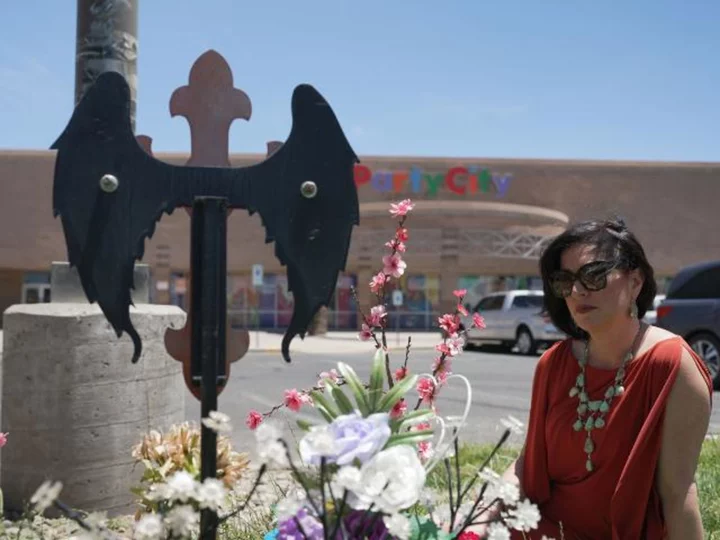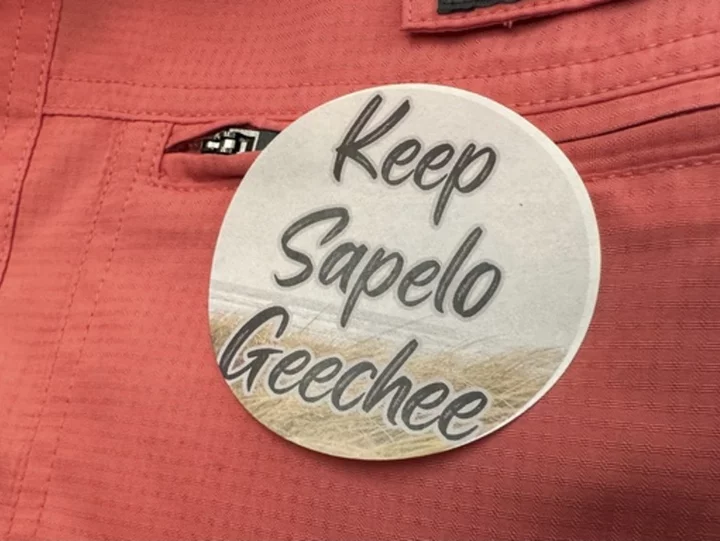Vanessa Salgado's nightmare began on what should have been a regular evening in the spring of last year, while she was waiting for her boyfriend to bring back tacos from a fast-food restaurant.
Before he arrived at her house in Albuquerque, New Mexico, Salgado's 16-year-old daughter, Alexia Rael, came home and, with her out-of-town older sister on the phone, dropped a bombshell accusation: The boyfriend -- a 52-year-old bank manager -- had molested them both for years. Stunned, Salgado kicked Bradley Wallin, her partner of a dozen years, out of the house that night.
Weeks later, on Mother's Day, Wallin took out his revenge, gunning down Rael and her 16-year-old cousin with his 9 mm outside a party-supply store where the two teens went to buy Vanessa a card and balloons. Wallin then shot himself.
The double murder-suicide, some officials say, was a tragic missed opportunity to employ the state's red flag law, which enables authorities to swiftly and temporarily remove guns from the hands of people who pose a danger, and prevents them from purchasing new ones.
A CNN review of red flag laws identified major obstacles even in states that have embraced them: Resistant law enforcement officers, stickler judges and a general lack of awareness and education have hindered the effectiveness of such gun safety measures that experts say can save lives.
Perhaps the starkest example of the unfulfilled promise of red flag laws is New Mexico, where two mass shootings in May left a total of six people dead and 11 wounded. Since its enactment in 2020, New Mexico's red flag law has been invoked less than 35 times.
That, gun-safety advocates say, is a fraction of what it should be in a state that suffers from one of the highest rates of gun violence and suicide in the nation -- leaving some, such as Vanessa, ill-protected against the devastating brutality of firearms.
"It's not being used in any meaningful way," said Sheila Lewis, a gun-safety advocate who works with the nonprofit group New Mexicans to Prevent Gun Violence, referring to the law. "It's really depressing."
More than a year after the horrific shooting in the parking lot of Party City, Vanessa Salgado remains haunted by the loss, and tortured by an unending loop of "what if" questions. She doesn't understand why deputies she called for help didn't inform her of the law that may have prevented the murders.
"It infuriates -- me the fact that they didn't lead me to the correct path," said Salgado, 45, who works as a finance manager at an auto dealership. "He's not in his right mind if he's molesting people. He shouldn't have possession of those guns."
During the investigation, Salgado said she didn't just tell deputies about Wallin's guns, she showed them.
"They came into the bedroom and they said, 'Well where is his stuff?'" she told CNN. "And I opened the drawer, where his underwear drawer was -- where the guns were."
A spokesperson with the Bernalillo County Sheriff's Department told CNN that deputies did not pursue a red flag order against Wallin in part because he had no known criminal history. But the county's new sheriff, John Allen -- who wasn't in his post at the time of the incident -- says deputies should have tried, as the law allows, to file a petition in court to have the guns removed.
"The least we could do is petition," he told CNN. "Anything to cause a hurdle (to committing violence) or anything to cause a cooling down period is what's most important to me as a sheriff."
Gun culture in New Mexico is alive and well
Home to sprawling ranching counties, high poverty and border regions with rampant drug trafficking, New Mexico has more than its share of public-safety challenges.
Of the 21 states (and District of Columbia) that have a red flag law in place, New Mexico is by far the most gun-violent.
A rare blue state that is largely rural, the Land of Enchantment has the third-highest rate of gun mortality in the US, according to 2021 data -- the latest available -- from the Centers for Disease Control and Prevention.
"It is the West," said state Rep. Joy Garratt, a Democrat who was among the sponsors of the bill that became the red flag law. "People live in isolated ranches and they have guns and rifles."
Last summer, President Joe Biden signed a landmark piece of gun-safety legislation setting aside $750 million for states that implement initiatives such as passing or strengthening red flag laws.
It's too soon to say whether New Mexico's share of that money -- $2.85 million -- will boost usage of the law, which enables judges to order respondents to relinquish their weapons within 48 hours.
But the state's faltering rollout of the red flag law is a case study that illuminates three of the great challenges for the measures across America: spreading public awareness, ensuring ease of use for citizens and getting buy-in from the very law enforcement agencies that are often charged with handling the cases.
New Mexico's systemic challenges also extend to the judiciary branch, where one district -- to the chagrin of people who'd expressed serious concerns about safety in their filings -- has yet to approve a single one-year firearms removal in any of the seven cases that have come before it.
The fiercest resistance in New Mexico, however, has been put up by sheriffs, some of whom have vowed not to enforce the law, which, like others across the country, is adjudicated not in the criminal courts, but the civil judicial system.
When the law was still a bill, the New Mexico Sheriff's Association strenuously opposed the proposal. Behind-the-scenes help came from the National Rifle Association in the form of ghostwritten op-ed pieces for local media outlets and letters to lawmakers, according to records obtained by the pro-gun safety group Brady United.
In one email, a media liaison from the NRA Institute for Legislative Action offered to rejigger a statement from the then-president of the New Mexico Sheriff's Association, Tony Mace, into a piece for a newspaper.
"Hello Tony!" she wrote. "Would you be interested in having me reformat your statement and turn it into a guest column format that you can submit to the Albuquerque Journal?"
While it's unclear whether Mace took her up on the offer, sheriffs in several counties submitted identical op-eds to their local newspapers, prompting at least one newspaper to post a disclaimer saying the column was written by NRA lobbyists.
Law enforcement in other states have pledged not to enforce red flag laws, including Colorado and Michigan. But the recalcitrance has been particularly extreme in New Mexico.
In 2019, before the red flag proposal was passed and signed, 29 of the state's 33 sheriffs signed a declaration of opposition against it and other gun-safety bills. This resulted in at least 25 counties passing "Second Amendment Sanctuary resolutions" to express support for sheriffs who spoke out against -- and in some cases refused to recognize -- gun-safety measures.
The most vocal among them was Mace, also the former sheriff in Cibola County. Mace declined an interview request for this story, and the current head of the New Mexico Sheriff's Association did not return calls and emails seeking comment.
"These red flag bills are just a backdoor gun-confiscation legislation," Mace, who has since become a magistrate judge, said on a pro-gun podcast in 2019. "If I have to go to the judge and get held in contempt of court to prove a point, I'm ready."
(Magistrate judges serve a low court in New Mexico and do not preside over red flag cases.)
Some critics worry that the law could be weaponized by people with a vendetta, such as a former spouse who wants to punish their ex by requesting that the government take their guns away, even if they've done nothing to warrant it.
Adam Winkler, a professor and expert on constitutional law at the UCLA School of Law, said he knows of no cases in the US in which red flag measures have been abused in that way.
But he noted that the laws could be vulnerable on constitutional grounds under the current US Supreme Court, which expanded Second Amendment protections last year in a landmark decision.
"If the court is sincere about its view that only those gun laws that are consistent with the gun laws of the 17- and 1800s are constitutionally permissible, then red flag laws are certainly likely to be called into question eventually," he said.
At the time of the murders committed by Wallin, the sheriff serving the Greater Albuquerque area -- Bernalillo County -- was Manny Gonzales, who termed out at the beginning of this year.
Although he was not among the many sheriffs who signed the declaration of opposition, Gonzales, who declined an interview request for this story, did appear on NRATV -- a public-relations outlet for the country's most powerful gun lobby -- to express personal support in 2019 for the Second Amendment Sanctuary movement.
Allen -- Gonzales's successor -- has made it clear that he will enforce gun-safety laws, including the red flag statute.
"The resistance towards the law, I don't believe that's appropriate," he said. "I don't think we can pick and choose our laws within law enforcement."
It's difficult to know the extent to which sheriffs in Second Amendment sanctuaries are refusing to recognize the red flag law in New Mexico. But more than three years after the law's inception, precious few red flag cases -- just two to date -- have been brought to the courts by a sheriff department in a Second Amendment Sanctuary county, according to CNN's analysis.
The challenges go beyond defiant sheriffs
Defiant sheriffs haven't been the only institutional barrier to more frequent use of New Mexico's red flag laws. So have stickler judges.
Each red flag case generally involves two rulings by civil judges: whether to make a decision to remove a person's guns for a period of about 10 days, and whether -- after the emergency removal -- to extend that weapons ban for a year. The latter decision happens at a hearing that includes the respondent.
The judicial district serving the state's northern region has struck down every request for a one-year firearm removal that has come before it, and all but three temporary requests.
Among the denied requests was one filed by a state police officer after a high school principal alerted authorities to the concerning behavior of a troubled student in Rio Arriba County.
In addition to having an abysmal attendance record and getting suspended for bringing knives to campus, the student had guns at home -- one of which he used to kill prairie dogs -- and made students and teachers afraid with frequent insinuations about shooting up the school, according to court documents.
For instance, the teen -- who told the officer that his comments were made in jest -- assured friends that he'd tell them to wear yellow beforehand, presumably so he wouldn't aim at them during a school shooting.
The judge denied the request to confiscate the five guns at the student's home for a year because it "failed to meet the requirements of the statute," but the ruling does not elaborate further. The judge, T. Glenn Ellington, did not respond to requests for comment.
Former state Rep. Daymon Ely -- another sponsor of the successful red flag bill -- wasn't familiar with the ruling, but he said if a school principal and police officer found the situation sufficiently alarming to put their names on the line about a potential school shooting, the court should err on the side of listening to them.
"This idea that you got to wait until the kid actually comes to class with a gun and starts shooting, then you can do something, is just irresponsible," said Ely, who retired his seat early this year. "What's the flip side? That the kids should be free to be able to go to school and threaten everybody and there's no consequences to that? I'm sorry, but yes, of course, you get in there and you solve the problem before it becomes a fatal problem."
Another judge in that district, which serves three counties -- Los Alamos, Rio Arriba and Santa Fe, home to the touristy state capital -- has taken a technical approach to applying the law, and in so doing appears to have devoted more focus to determining who can initiate a red flag case than to considering the level of the threat.
Judge Sylvia LaMar has presided over four cases; none ended with a one-year removal.
They included a suicidal man who told a crisis hotline operator that he wanted to shoot himself; a city of Santa Fe employee with rifles at home and a violent criminal history who allegedly told his boss "did your parents have any kids that lived because you should be dead"; and a former Army investigator who allegedly harassed and repeatedly threatened to shoot her family physician for refusing to prescribe her the pain medication he feared she was addicted to.
LaMar's rejections in all three of those cases cite her belief that the people initiating them were not authorized to do so under the state's red flag law. Her denial of the one-year order in the fourth case -- which is sealed from the public -- is being challenged by the state.
At issue is a clause in the law: It says the people who can initiate the process of removing weapons from someone includes employers, school administrators and a list of family members and intimates. (The law also mandates that law enforcement serves as the middlemen, meaning only they can bring the cases directly to the courts.)
In the three publicly available cases that LaMar rejected, the individuals making the initial request to remove a person's weapons were a psychiatrist, a police detective and a physician; none of these professions is included in the list of examples in the statute. LaMar's rulings are in conflict with a 2021 opinion issued by the state's attorney general, who stated that "any person" can make an initial request. (Importantly, this includes law enforcement officers themselves.)
But LaMar was unmoved.
"The statute is the statute; it's very specific," she told CNN. "I don't read 'includes' in the statute as opening the door to anyone and everyone, because when that was discussed and passed, I'm sure that came up. And it's been limited to this list of people."
The state's attorney general disagrees, and his appeal of one of LaMar's decisions is expected to bring clarity to the question of who can serve as what the law refers to as a "reporting party."
In the Wallin case, the institutional confusion about red flag laws also seems to have played a role in how a nonprofit group of lawyers that work with domestic violence victims didn't seek to use the statute to remove Wallin's guns.
Jennifer Kletter, an attorney with New Mexico Legal Aid, helped Vanessa Salgado file a domestic restraining order against Wallin. In that document, dated April 4, 2022 -- a little over a month before the murder-suicide -- Salgado listed Wallin's two handguns, a 9 mm and a .380 Ruger, and wrote that he had threatened her daughter.
Kletter also told CNN that after reporting the sexual abuse, Salgado's daughter, Rael, had created a "safety plan" in which she said she felt safer if she was accompanied at all times by her 16-year-old cousin, Mario Salgado-Rosales, who would also be murdered by Wallin in the parking lot.
But despite Rael's apparent fear of Wallin, Kletter didn't inform Rael's mother of the red flag option when working on the restraining order with her. Kletter told CNN this is because she doesn't believe law enforcement officers would have followed through with filing it.
"He would have typed (Wallin's) name in their system and seen zero criminal (history)," she said.
Kletter added that, even if a case had been filed, she believes Wallin would have won a red flag case in court, given his lack of a criminal history and other factors listed in the statute.
But Lewis, the gun-safety advocate -- who is also a lawyer -- strongly believes a red flag order should have been filed in Wallin's case, especially in light of how the court had granted Salgado and her daughter a short-term, emergency restraining order against Wallin after the initial accusation.
"One of the most significant triggers for people who are at risk of using a firearm is getting served with a domestic violence order of protection," she said. "So that would certainly make it clear to the court that the danger was imminent."
Kletter did take some ownership for not informing Salgado of the red flag option.
"I knew it existed at the time. And as her attorney, I did not know how she would go about doing that," she said. "And that's a fault on my part."
Mass shootings averted in Albuquerque?
Lackluster pickup of the law is also the product of ignorance -- on the part of the general public and law enforcement alike.
To boost awareness, Democratic Gov. Michelle Lujan Grisham launched an effort last summer to educate the public and provide training for law enforcement, school officials, judges and other professionals.
The initiative seems to be making some headway. Fourteen red flag petitions were filed during the first five months of 2023, or nearly half of all 34 cases filed to date, according to CNN's analysis.
But the recent uptick is largely the product of a single unit within the Albuquerque Police Department, which sits in Bernalillo County, one of the few New Mexico counties that has not declared itself a Second Amendment Sanctuary.
Commander Matt Dietzel heads up that unit, called Crisis Intervention, which handles mental health calls.
For the first couple years of the red flag law's existence, Dietzel's unit filed zero cases. The reason: He, much like Judge LaMar, thought only certain people -- such as family members -- could initiate the red flag process. When he learned about the AG's opinion that anyone -- including law enforcement -- could do so, it was a game-changer.
"I was like, 'let's try it,'" he said.
Today, Dietzel's unit is responsible for about a third of all the cases that have been filed across the state.
Dietzel believes New Mexico's law has flaws. For instance, he wishes judges were available 24/7 to make emergency approvals after business hours -- when they are often needed most urgently -- as is the case in Maryland.
But he thinks New Mexico's statute is a good start.
"We've had a couple of really, like -- if we hadn't acted, I'm pretty sure they would have committed a mass shooting," he said.
In one, a US Army infantry veteran with PTSD and a violent criminal history who'd made repeated threats to shoot up a large church -- including a text message to a pastor saying "ILL KILL YOU ALL" -- slipped into the back door of the building on a Sunday last July dressed in camouflage. Somebody called the police, who took the man to a psychiatric hospital and filed a red flag case that resulted in the relinquishment of the man's AR-15 style assault rifle and two semiautomatic handguns.
Another involved a 17-year-old boy who'd been disciplined at Eldorado High School in Albuquerque for making homophobic, antisemitic and racist remarks and gestures, such as draping his lunch table with a Confederate flag, and for allegedly threatening another student with a knife on school grounds. The teen had been posting disturbing photos on social media, including one of himself gripping a pistol. Moreover, police said the student had gone to the "Right To Bear Arms" gun store located next door to the school to inquire about purchasing a magazine for an AK-47 assault rifle.
A recent Johns Hopkins study found that red flag laws -- often referred to as "Extreme Risk Protection Orders," or "ERPOs" -- temporarily disarmed more than 660 individuals across six states who expressed a desire to kill at least three people. New Mexico was not a part of the study.
"We're not suggesting that all 600-plus of these cases that we identified would have -- were it not for ERPO -- gone on to result in multiple people being shot and/or killed," said Shannon Frattaroli, a lead author of the study. "But even if a small percentage of those (shootings) didn't happen as a result of ERPO, that's pretty good."
Standing in sharp contrast to New Mexico are Florida and Maryland, two of the most prolific users of the law on a statewide basis, Frattaroli said.
Maryland, where more than 3,600 red flag cases have been filed since its fall 2018 inception, excels at ensuring that court processes are in place to receive petitions from family members, she said. Florida, where a whopping 11,000-plus cases have been filed since its law took effect in early 2018, has several champions among certain leaders in law enforcement.
"Law enforcement can be our greatest allies with regard to red flag laws," Frattaroli said. "Once they roll up their sleeves and learn about what these laws actually do -- once they learn that these laws are very similar to the laws that are in place with regard to domestic violence protections -- people see the potential to improve community safety."
Experts still don't know whether red flag laws have measurably moved the dial on gun deaths, mostly because the statutes are so new. The vast majority came into existence after the 2018 school shooting in Parkland, Florida.
However, some academic research has shown lower-than-expected rates of firearm suicide in states with the oldest red flag laws.
That could have real implications for New Mexico, which has the fourth-highest rate of suicide in the nation, according to the CDC.
The city of Albuquerque, meanwhile, has been grappling with increased violence. In each of the two years after New Mexico's red flag law took effect in 2020, the city logged a new homicide record.
It wasn't until the middle of 2022 that the Albuquerque Police Department -- through Dietzel's unit -- would initiate its first red flag case.
An armed man's manic episode
The call on May 23, 2022, came from the distraught mother of a 37-year-old bipolar man who says he was in the throes of a manic episode. Officers were so concerned about sending him over the edge they didn't knock on his door.
The man, they were told by his mother, had been making vague threats against himself and others. She also said he'd placed a bowl over his head to keep other people from entering his brain. Speaking with an officer on the phone, the man -- who CNN is not naming out of respect for his privacy -- said he could see orbs floating around his guns.
The officers summoned him out to the street. The man, who says he's a software developer and former Air Force mechanic, got into his Toyota Supra, rolled slowly over to the patrol vehicles, pulled down his sunglasses and stared at the officers, according to a police report. Then he peeled away, burning out his tires and "driving off recklessly" before parking in an alley and sprinting back into his house, partially clothed.
The officers eventually took the man in for a mental-health evaluation and utilized the state's red flag law. Police called the man's mother -- who lived in a different house nearby -- and asked if she and her husband could bring in the man's weapons, which had been sitting in an open case next to his bed. The arsenal included an AR-15 style assault rifle with a fully loaded magazine, three loaded pistols, a large bowie knife and more than 50 loaded cartridges of ammunition.
A year later -- weeks before he was scheduled to get his guns back -- the man told CNN he is currently stable, and believes police weren't wrong to file a red flag order against him.
"At the time, with everything that was going on," he said, "I'm not saying that I wanted to kill myself, but it was probably best that I don't have guns."









